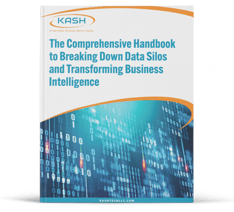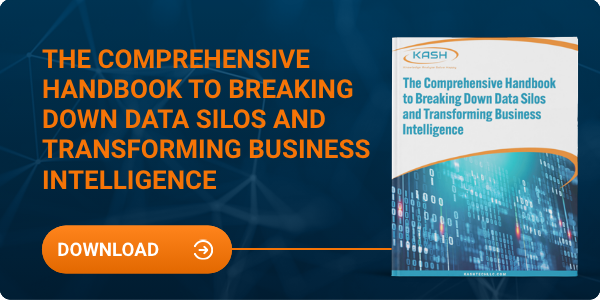Top 2 Strategies to Ensure Data Accuracy and Quickly Diagnose Errors
Topic:
Data Silos
Our blog on the cost of poor data quality highlights the importance of clean data as the foundation of becoming a truly data-driven enterprise. Conversely, inaccurate data causes inaccurate reporting and misleading information for decision-making.
So, here’s the problem: How do you diagnose and correct data inconsistencies and errors so you can get to the monetization stage? Obviously, what’s the point in reporting inaccurate data? You only go down the GIGO (garbage-in-garbage-out) daisy path to a cul-de-sac of error-ridden business suppositions made on false assumptions.
About this Post
This post will cover two strategies to diagnose errors and improve data accuracy quickly:
1. Know and fix the most common sources of data errors—human and otherwise.
2. Apply four essential components of an enterprise approach to data accuracy from the perspective of applied technology.
Know the Common Types of Data Errors
The aforementioned data-GIGO trail is littered with errors that contaminate data warehouses and data lakes/marts. Those errors require both human and automated attention to prevent risks and ultimate damage to the enterprise. Those risks include:
- loss of revenue
- wasted marketing/media dollars
- inaccurate/ill-informed business decisions
Common types of data errors are the result of the following:
- Human error at the data entry point; e.g., the input form was filled out incorrectly, or the data was entered incorrectly.
- Optically scanned (OCR) data that was either scanned or translated/transcribed incorrectly.
- Duplicate data that was entered and undetected multiple times in the system.
- Data that was calculated incorrectly and inaccurately transformed.
- Data that was incomplete, i.e., critical data is missing—the address information is not fully filled out.
 Discover how your organization can break down data silos that are a barrier to ensuring data accuracy.
Discover how your organization can break down data silos that are a barrier to ensuring data accuracy.
Download the eBook:
The Comprehensive Handbook to Breaking Down Data Silos and Transforming Business Intelligence.
There is plenty of advice and guidance on ensuring data accuracy at its point of entry. However, common themes include identifying the following:
- The sources of data inaccuracy—data migration from one database to another, customer status changes, etc.
- Realistic data accuracy goals for the data entry team.
- Training methods for data entry personnel in the importance and relevance of the data they are entering.
- Situations where work overload and employee burnout are impacting data quality.
- Ways to generate and review data output error rates.
- Employing software tools that automate workload, collect, read, and extract repetitive data to reduce keyboard fatigue and data-entry errors.
Harness the Components of an Enterprise Approach to Data Accuracy
An enterprise approach to data accuracy goes far beyond the do-it-yourself human touch approach. Clean data must be discovered, trusted, synchronized, and optimized. That discovery, trust enhancement, wrangling, and optimization are the products of automated tools, which include:
- Data Profiling and Modeling
- Automated log files (may leverage SQL for interpretation)
- Master Data Management tools
- ETL or capabilities bundled with specifically engineered analytics software
The Basic Components of Ensuring Data Accuracy
Component 1: Data Discovery
This includes data and API connectors to discover data sources and schemas automatically. In addition, data discovery builds maps and processes from the data at the source and has pattern detection capabilities.
An example is data profiling software, which scans and detects sets of data attributes for unique values. Those unique values aggregate into a better understanding of the distribution and determine when standardization needs to be applied. This can also be done through SQL.
Component 2: Trust in the Data
This involves automated data quality features to:
- Reliably detect data errors
- Include machine learning data quality check suggestions
- Monitor data
- Have data cleansing processes
An example would be automated log files and reporting methods to extract information the enterprise needs to make the most informed decisions.
Component 3: Synchronize the Data
Synchronizing the data requires matching and merging your sources into a single cleansed “golden record” and the enterprise’s single source of truth. The process may include applying data quality rules and generating a need involving manual remediation.
Software applications include Data Quality and MDM (Master Data Management) complex software.
Component 4: Optimize the Data
Optimizing data requires the following actions:
- Automating the data prep and cleansing processes for analytics.
- Making sure the accurate data is accessible to all users within the organization. This means tearing down data silos and instilling a data-driven culture throughout the organization.
The foregoing is typically a repeated process to determine what the optimization should consist of. This could be accomplished through ETL, and purpose-built software. Alternatively, the functionality may be packaged with analytics and reporting capabilities.
Summary Points
Inaccurate data or data errors always lead to inaccurate reporting or data inconsistencies. Those errors can negatively impact the decision-making of an organization. Worse, bad data could interrupt the organization’s revenue stream.
So, it is vital to work with someone who understands the impact that inaccurate data may have within an organization and has the experience to guide and implement processes and methodologies to ensure accurate and consistent data.
Read more about how you can begin or continue your journey to develop a data-cleansing strategy. Download the eBook, The Comprehensive Handbook to Breaking Down Data Silos and Transforming Business Intelligence.
